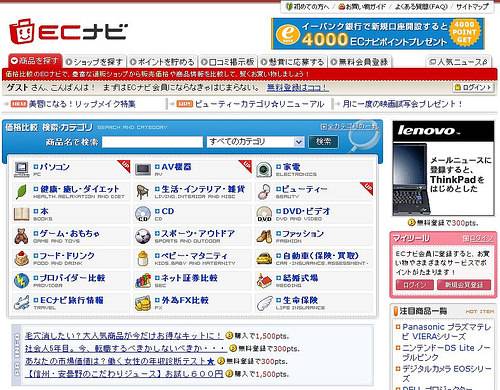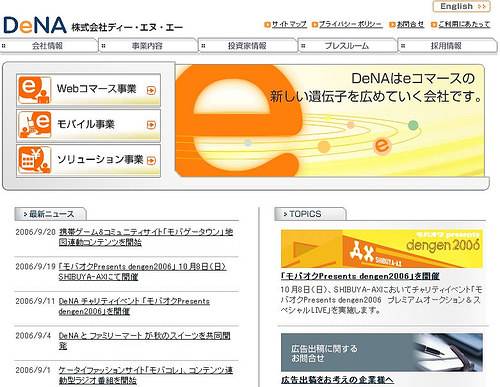Next in our
series on international Web markets is Japan. The information for this post was provided
by Benjamin Joffe (CEO of Plus Eight Star Ltd) and
Masashi Kobayashi (partner of Globis Capital Partners – one of
the largest Venture Capital firms in Japan). We start off with an overview of the market,
then list the main web companies in Japan. There is some extra commentary after that on
why mobile dominates in Japan, the state of online advertising in Japan and its IPO
market. There’s something for everyone here! Thank you Benjamin and Masashi for the
comprehensive and very interesting information about Japan’s Web.

Overview
Benjamin: Japan today enjoys not only the fastest but also the
cheapest broadband infrastructure in the world, with over 20 million households
connected to broadband (out of 46 million). Yahoo! Japan, through its Yahoo! BB service,
is among the largest providers with over 5M users. You can get 8M to 50M ADSL for prices
between $20 to $45 a month, and 100M fiber optics for a $200 set-up fee and $30 monthly
fee. There goes the myth of ‘Japan does not have the Internet’!
Masashi: As a result of the aggressive entry by Softbank BB (aka Yahoo! BB),
Japan today enjoys a very cheap and very high-speed Internet infrastructure. In addition,
on the mobile side there is a very large diffusion of 3G and 3.5G feature-rich handsets
and a solid wireless infrastructure. One thing to point out is that even with the growing
usage of video-based services like Youtube, or movie content, there is not much stress on
the network. In March 2006, more than 2 million Japanese and 5.2% of Internet users used
Youtube! (ref).

Benjamin: Japan is 1.5 years ahead of US in mobile? It is difficult to
come up with an estimate, but the market maturity goes way beyond simply: “do they have
more 3G users?”. Here are some data points:
- Over 50% of the 90+ million Japanese mobile phone users have 3G (W-CDMA, CDMA 1x or
CDMA EV-DO) - 85% have a mobile data connection for mobile email and over half of this number use
mobile services *regularly*
A lot of people in Japan buy not only digital (music, games, videos) but “real” or
“offline” goods on their mobile. They use auction services, blogs and use assisted-GPS
powered navigation services to walk the city. And they have been doing so for already 2-3
years, at least. Market maturity is not only about getting a device in people’s hand, it
is also about the service offering and the actual usage rate. Same for Internet: you can
have a great infra with high-speed and no innovation.
Top Web 2.0 companies
Masashi: Unlike Silicon Valley, there are only a few high-quality services in
Japan. The main reason for this is that there are only a handful of high-quality
entrepreneurs. When magazines publish articles about Web 2.0 in Japan, Mixi, GREE, Hatena
and Drecom appear all the time, but there is little mention of anyone else.
MIXI

Benjamin: Japan’s largest SNS is named MIXI and
has gone last week (Sept 18) onto the Japanese Mothers stock market. Its market cap
reached 109 billion yen (US$930m), which makes the IPO the seventh-largest on the Mothers
market. Its CEO Kenji Kasahara (30 y.o.) set up Mixi in June 1999 when he was a
third-year student at the University of Tokyo. The company initially operated a
recruitment advertising Web site and launched a social networking service in February
2004. In the year ended March, Mixi posted a pretax profit of 900 million yen (US$7.5m)
on sales of 1.8 billion yen (US$15m). A large part of the revenue comes from advertising.
Mixi’s membership totaled 5.7 million as of Thursday. About 70 percent are those in their
20s and younger.
Masashi: The company whose development is the most interesting is probably
Mixi. Mixi is Japan’s leading SNS service. Its number of pageviews is second only to
Yahoo! Japan. In September this year, Mixi IPOed and is valued currently at 200 billion
JPY ($1.7 billion). With its profits rising rapidly, Mixi has become the flagship of Web
2.0 businesses. There is good information about Mixi here (English
PDF).
GREE

Benjamin:GREE is Japan’s second largest social
network (founded in February 2004). Japan’s second largest operator, KDDI, invested $31
million in July 2006 to develop a mobile version – marking its entry in the
“mobile community age”.
YAHOO! DAYS

Benjamin: The third major site is operated by Yahoo! Japan (under control of
the holding company Softbank) and is named Yahoo!
Days, roughly based on Yahoo! 360. More is expected to develop, as Softbank bought
out Vodafone’s operations in Japan and got control of its 15 million mobile phone
subscribers.
Masashi: In Japan, Web 2.0 services introduced by Yahoo! Japan are not doing so
well – many of the key Yahoo engineers have moved to Hatena, GREE and other companies
In addition, Google’s presence in Japan is very weak. Yahoo! Japan controls 20-30% of
the search market – the rest belonging to a variety of local players. Though Adwords and
Adsense are widely used, other Google services have few users and little recognition.
Interestingly, quite a few Japanese startups are hoping to build Web 2.0 businesses like
Google.
HATENA

Benjamin:Hatena is a blog and social
bookmarking service, quite similar to del.icio.us.
Masashi: Hatena Bookmarks has grown to be Japan’s largest Social Bookmarking
service. It has diversified into other services, such as Hatena Diary (Blog service).
Overall, Hatena is a service more directed to the IT-literate.
EC Navi

Masashi:EC Navi is the second largest price
comparison engine after Kakaku.com (“price.com”). Thanks to its automatic price
collection, it now has Japan’s largest number of registered goods. With the recent
opening of the EC Navi Lab, the site has started to offer Web 2.0 features like social
bookmarking and cooperating with other existing price comparison sites. A majority of its
users are girls and young women.
DeNA

Masashi: While DeNA is the third ranking
auction site, its mobile service which opened a few years back has achieved a tremendous
success. Its quick gathering of users had a lot to do with its cooperation with the
mobile affiliation site Pocket Affiliate. Riding on the success of its mobile auction
site, its new site “Mobile Game Town” is growing rapidly. Offering free casual game
including SNS elements, this new type of community site has grasped the interest of young
users. Revenues come from the huge traffic and advertising revenues from affiliate
networks. The “Mobile Game Town” service started in February 2006 and in 156 days (July)
achieved 1 million users. This service targeting students and housewives has three points
of interest:
(1) High quality mobile games with avatar, diary, BBS (forums)
(2) Fast growth as an all-free content site The most distinctive feature of the mobile
community site is the ability to post to the diary and forums, with the same ease as when
sending regular emoticons-rich mobile emails (Japan more or less dropped SMS in favor of
rich mobile email in early 2000). With this ability to post anytime and from anywhere,
users can react and see reactions from others at a much faster pace than when using a
computer. In addition, the use of avatars increases the capacity to show emotions in
messages. Service usage increases through word-of-mouth and its current monthly pageviews
averages 1.5 billion per month (about 52 million daily PV).
(3) The site is today the largest mobile community site in Japan.

Note: Japan’s mobile advertising market is growing at a fast pace through affiliate
marketing.
OTHERS
Benjamin:Startforce is a kind of
“start page” service. Kizasi is a Technorati lookalike,
showing what are the current hot topics in the bloggers community through a keyword
ranking and an original chart – very easy to read. Hyakushiki is a social bookmarking service with a
focus on hobbies and technology.
Why does Mobile dominate in Japan?
Benjamin: Why is there so much mobile action and so little on [PC-based]
Internet in Japan? People do not have Internet in their DNA here and I don’t buy the
cultural explanations.
I think this situation has a lot has to do with:
- Difficulty to get users to pay/monetize Internet services vs. clear payment systems
and good revenue sharing with operators on mobile - Possible lack of exposure to foreign innovative services, due to weak English skills
and self-supporting local market (Japan is the world’s second largest economy, after
all). - Recent financial scandal with Japan’s #2 portal site Livedoor creating a bad karma
around Internet entrepreneurs.
Strong online advertising market
Masashi: Japan has the world’s second largest GDP and its advertising market is
maturing into a very large one. As the Internet is shifting into a primary advertising
market, ad revenues for Internet companies are growing. On contrast to the US – and due
to the limited number of large Internet players in Japan – a large share of online
advertising goes to the dominant player Yahoo! Japan (a JV between Softbank and Yahoo! US
and managed locally). Hence, the rise of advertising revenues of recent SNS services like
Mixi and Gree has more to do with a lack of destinations for online
advertising.
IPO Market is hot
Masashi: IPOs from Internet-related companies are now coming, one after the
other, with a PER often getting over 100. Expectations are huge in the case of such a
famous service as Mixi – and the valuation has gone sky-high. The emerging individual
investors market in Japan is also supporting this economic comeback.
In Japan, shares reach on average twice the price of the offering after the IPO. As a
result, IPOs are a popular bet for private investors.
This second generation of entrepreneurs, who cashed stocks from the first wave of
Internet companies, are very professional. As an example, GREE was created by former
Rakuten executives.
The good shape of the IPO market stimulates in turn the Venture Capital industry, with
large Japanese players like JAFCO investing with high company valuations. JAFCO (largest
Japanese VC) set up last year a 100 billion JPY ($850 million) fund, while NIF SMBC (2nd
largest) created this year a 60 billion JPY ($510 million) fund. Due to the size of those
funds and the scarcity of valuable investment targets, the oversupply leads to pushing to
high valuations.
Summary
My thanks again to Benjamin and Masashi, who have provided us with a great overview of
the Japan Web market and its top apps. As always, there will be apps that we haven’t
covered, so I encourage you to add them to the comments. Also we’d love to hear your
views of the Japanese Web industry, if you’re familiar with it. And feel free to ask
questions in the comments, as perhaps someone from Japan will answer it.
This post is part of Read/WriteWeb’s continuing coverage of international Web markets.
Other countries profiled so far have been Germany, Holland, Poland, Korea, United Kingdom, Russia, Spain, China, Turkey, Italy, Brazil and France.

















